Abstract
This paper describes a rebreathing method for the simultaneous measurement of oxygen consumption (VO2) and effective pulmonary blood flow (QP. eff) at rest and during exercise. Subjects rebreathed a test gas consisting of 35% oxygen, 3.5% chlorodifluoromethane (freon-22), and 10% argon in nitrogen for 30 seconds or until the respired oxygen tension fell to below 13.3 kPa. Sixty normal subjects were studied on a motorized treadmill, the Bruce protocol being used. The rebreathing manoeuvre was performed at three minute intervals, and was initially practised sitting down. Measurements were then made with the subjects standing at rest, and subsequently during the last minute of each stage of the Bruce exercise protocol until the subjects were exhausted. Heart rate was recorded from the electrocardiogram. Oxygen uptake plotted against calculated power (watts) showed a discontinuity between resting and exercise values, probably because power output during treadmill exercise is underestimated. The arbitrary addition of 30 watts to the exercise power output abolished this discontinuity. There was good agreement between rebreathing estimates of oxygen consumption and values measured during a second exercise test by the conventional open circuit argon dilution method. Coefficients of variation of oxygen consumption and effective pulmonary blood flow measured by rebreathing were usually less than 10% even during maximal exertion. At rest mean (SD) effective pulmonary blood flow corrected for body surface area was 2.2 (0.46) l/min/m2. Effective pulmonary blood flow rose linearly with oxygen consumption. At rest the arteriovenous oxygen content difference for pulmonary blood (VO2/QP eff) was 9.1 (1.6) ml/dl, rising to a maximum of 16.4 (1.8) ml/dl. The stroke volume index was 27.5 (6.8) ml/m2, rising to a maximum of 46.5 (7.1) ml/m2 during exertion.
Full text
PDF
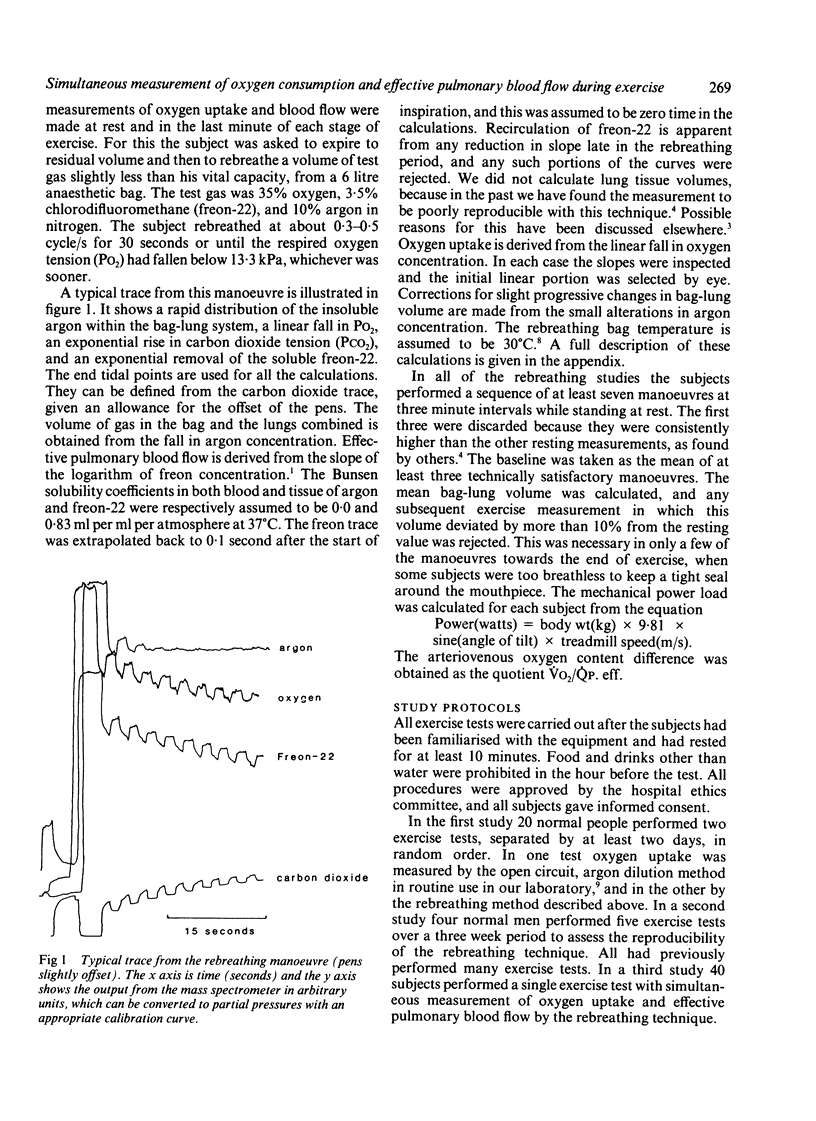

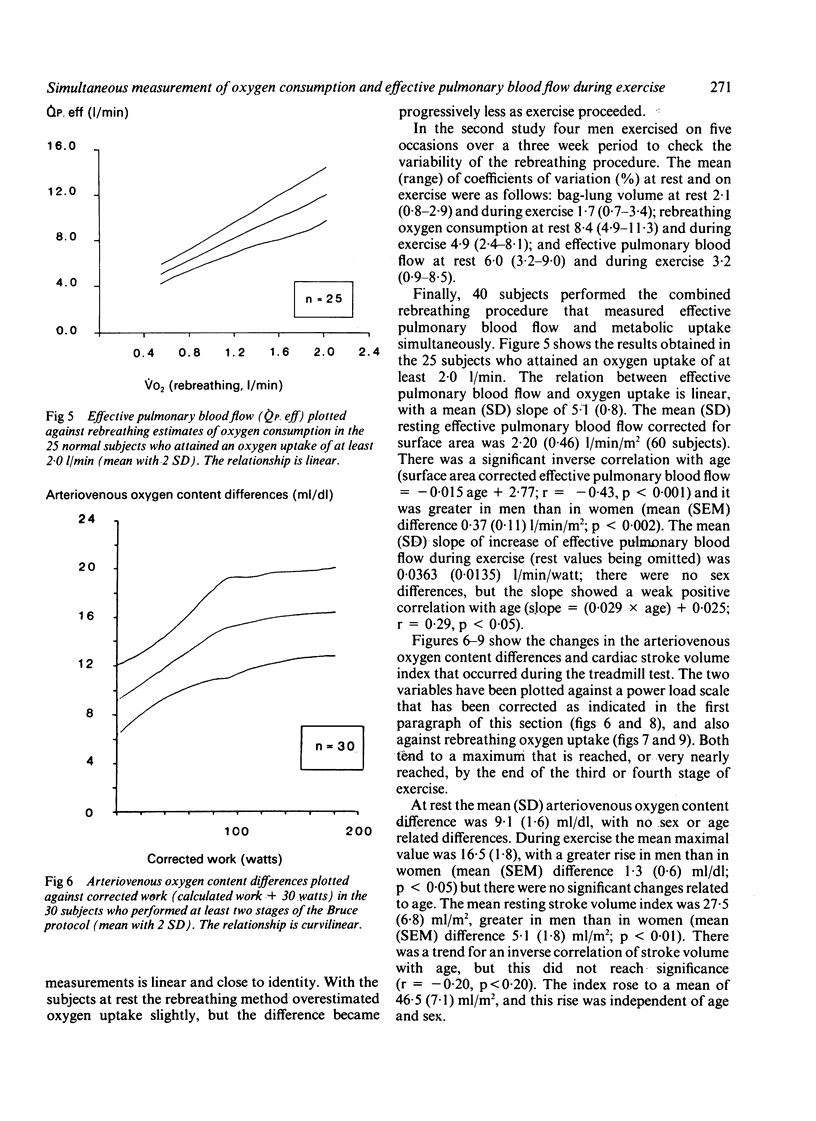

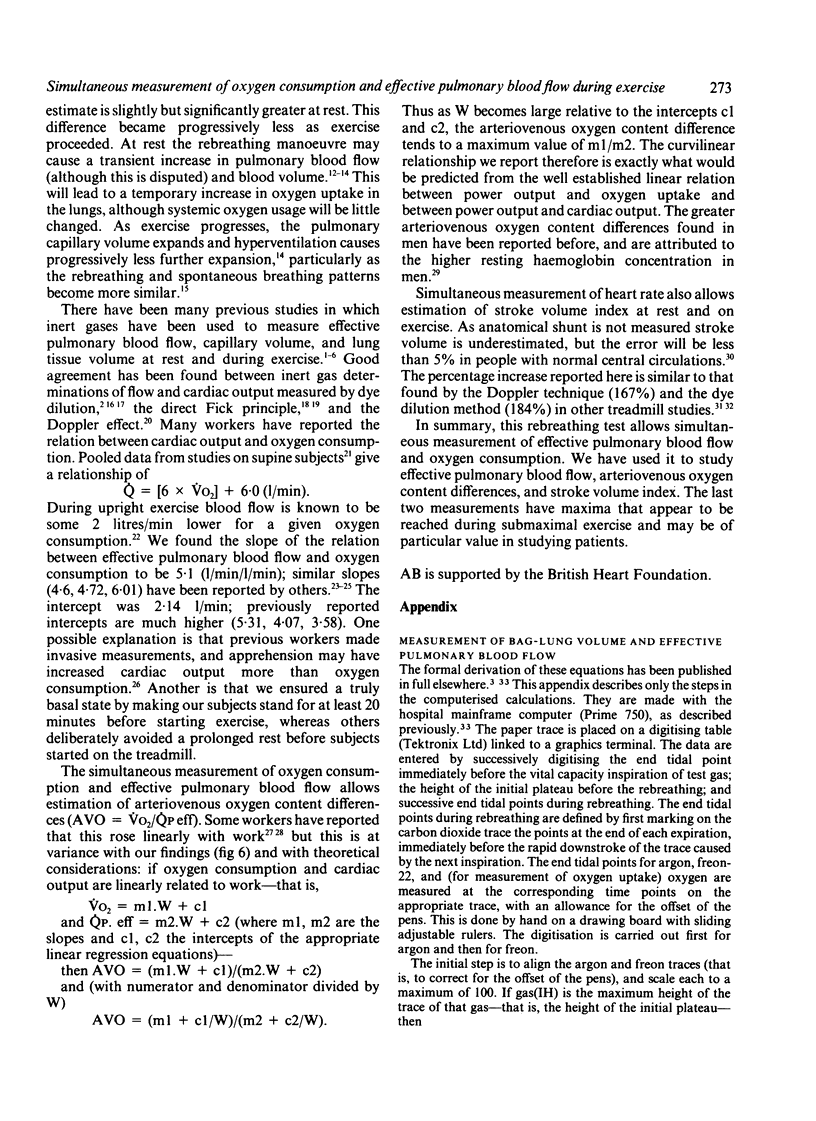
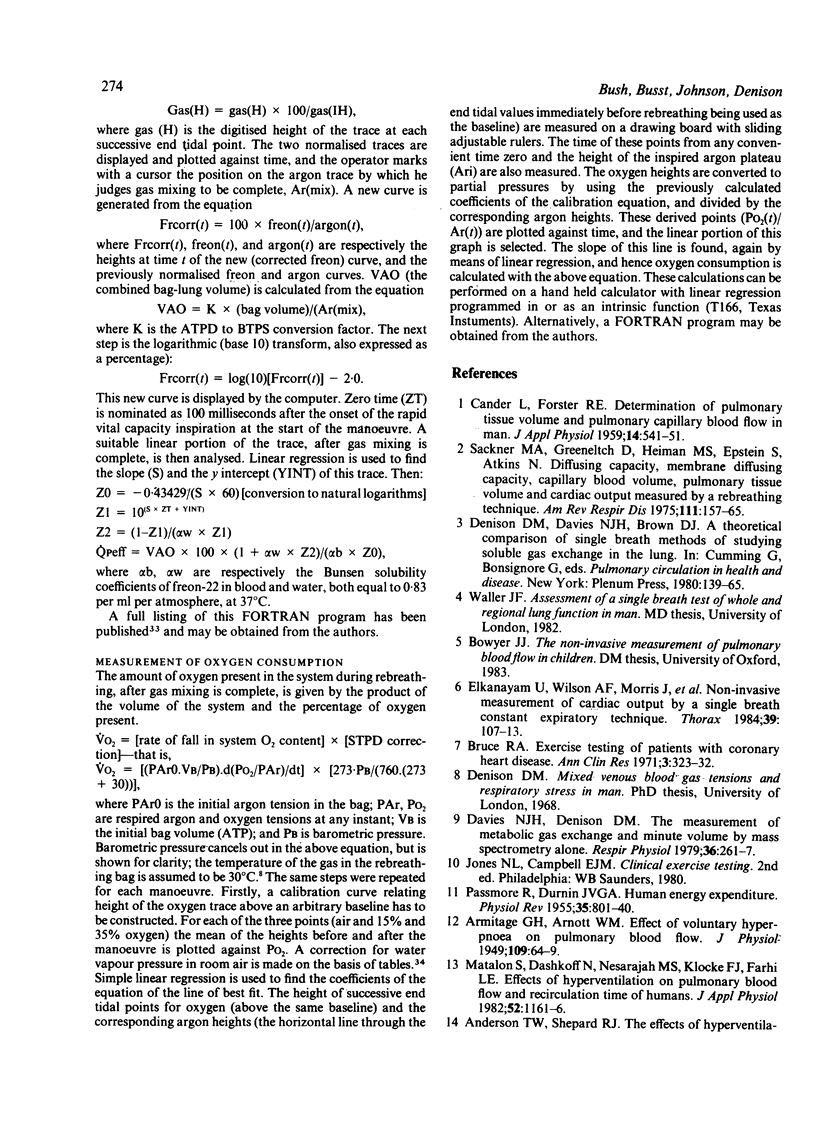
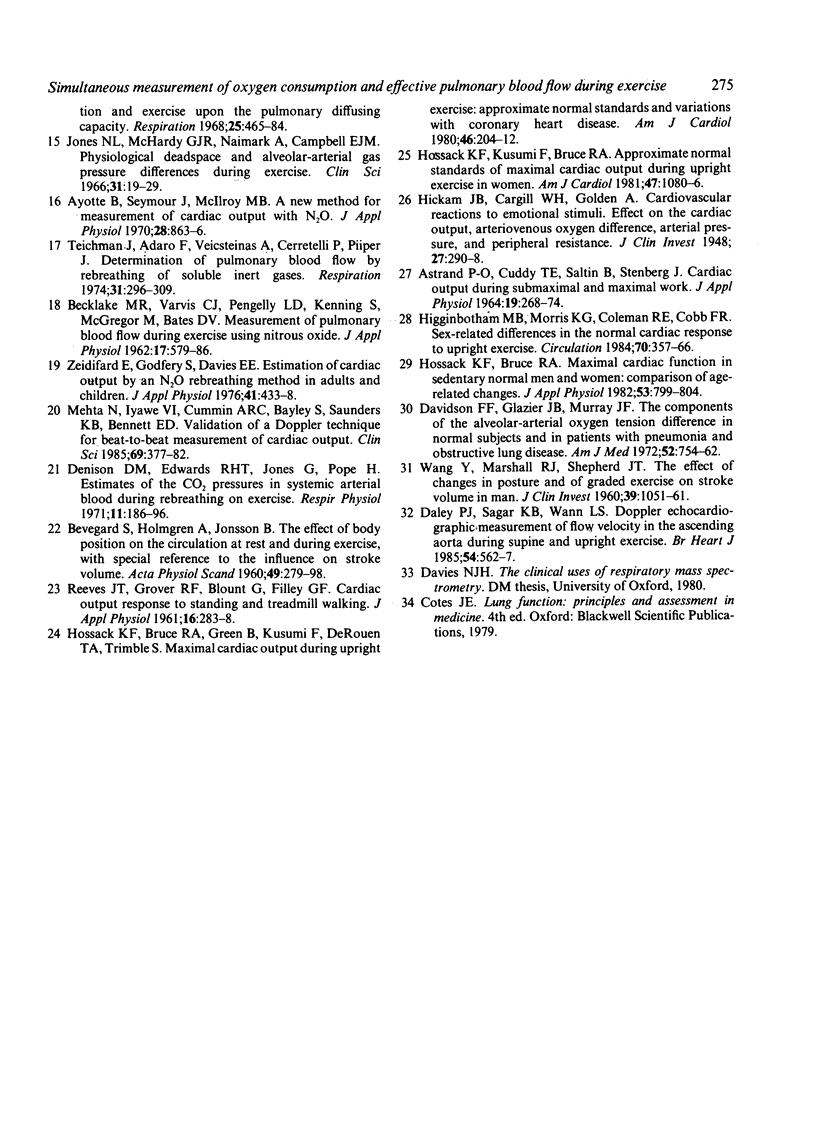
Selected References
These references are in PubMed. This may not be the complete list of references from this article.
- ARMITAGE G. H., ARNOTT W. M. Effect of voluntary hyperpnoea on pulmonary blood flow. J Physiol. 1949 Aug;109(1-2):64–69. doi: 10.1113/jphysiol.1949.sp004370. [DOI] [PMC free article] [PubMed] [Google Scholar]
- ASTRAND P. O., CUDDY T. E., SALTIN B., STENBERG J. CARDIAC OUTPUT DURING SUBMAXIMAL AND MAXIMAL WORK. J Appl Physiol. 1964 Mar;19:268–274. doi: 10.1152/jappl.1964.19.2.268. [DOI] [PubMed] [Google Scholar]
- Anderson T. W., Shephard R. J. The effects of hyperventilation and exercise upon the pulmonary diffusing capacity. Respiration. 1968;25(6):465–484. doi: 10.1159/000192581. [DOI] [PubMed] [Google Scholar]
- Ayotte B., Seymour J., McIlroy M. B. A new method for measurement of cardiac output with nitrous oxide. J Appl Physiol. 1970 Jun;28(6):863–866. doi: 10.1152/jappl.1970.28.6.863. [DOI] [PubMed] [Google Scholar]
- BECKLAKE M. R., VARVIS C. J., PENGELLY L. D., KENNING S., McGREGOR M., BATES D. V. Measurement of pulmonary blood flow during exercise using nitrous oxide. J Appl Physiol. 1962 Jul;17:579–586. doi: 10.1152/jappl.1962.17.4.579. [DOI] [PubMed] [Google Scholar]
- BEVEGARD S., HOLMGREN A., JONSSON B. The effect of body position on the circulation at rest and during exercise, with special reference to the influence on the stroke volume. Acta Physiol Scand. 1960 Jul 15;49:279–298. doi: 10.1111/j.1748-1716.1960.tb01953.x. [DOI] [PubMed] [Google Scholar]
- Bruce R. A. Exercise testing of patients with coronary heart disease. Principles and normal standards for evaluation. Ann Clin Res. 1971 Dec;3(6):323–332. [PubMed] [Google Scholar]
- Daley P. J., Sagar K. B., Wann L. S. Doppler echocardiographic measurement of flow velocity in the ascending aorta during supine and upright exercise. Br Heart J. 1985 Dec;54(6):562–567. doi: 10.1136/hrt.54.6.562. [DOI] [PMC free article] [PubMed] [Google Scholar]
- Davidson F. F., Glazier J. B., Murray J. F. The components of the alveolar-arterial oxygen tension difference in normal subjects and in patients with pneumonia and obstructive lung disease. Am J Med. 1972 Jun;52(6):754–762. doi: 10.1016/0002-9343(72)90081-2. [DOI] [PubMed] [Google Scholar]
- Davies N. J., Denison D. M. The measurement of metabolic gas exchange and minute volume by mass spectrometry alone. Respir Physiol. 1979 Feb;36(2):261–267. doi: 10.1016/0034-5687(79)90029-x. [DOI] [PubMed] [Google Scholar]
- Denison D., Edwards R. H., Jones G., Pope H. Estimates of the CO2 pressures in systemic arterial blood during rebreathing on exercise. Respir Physiol. 1971 Jan;11(2):186–196. doi: 10.1016/0034-5687(71)90023-5. [DOI] [PubMed] [Google Scholar]
- Elkayam U., Wilson A. F., Morrison J., Meltzer P., Davis J., Klosterman P., Louvier J., Henry W. L. Non-invasive measurement of cardiac output by a single breath constant expiratory technique. Thorax. 1984 Feb;39(2):107–113. doi: 10.1136/thx.39.2.107. [DOI] [PMC free article] [PubMed] [Google Scholar]
- Hickam J. B., Cargill W. H., Golden A. CARDIOVASCULAR REACTIONS TO EMOTIONAL STIMULI. EFFECT ON THE CARDIAC OUTPUT, ARTERIOVENOUS OXYGEN DIFFERENCE, ARTERIAL PRESSURE, AND PERIPHERAL RESISTANCE. J Clin Invest. 1948 Mar;27(2):290–298. doi: 10.1172/JCI101946. [DOI] [PMC free article] [PubMed] [Google Scholar]
- Higginbotham M. B., Morris K. G., Coleman R. E., Cobb F. R. Sex-related differences in the normal cardiac response to upright exercise. Circulation. 1984 Sep;70(3):357–366. doi: 10.1161/01.cir.70.3.357. [DOI] [PubMed] [Google Scholar]
- Hossack K. F., Bruce R. A., Green B., Kusumi F., DeRouen T. A., Trimble S. Maximal cardiac output during upright exercise: approximate normal standards and variations with coronary heart disease. Am J Cardiol. 1980 Aug;46(2):204–212. doi: 10.1016/0002-9149(80)90059-4. [DOI] [PubMed] [Google Scholar]
- Hossack K. F., Bruce R. A. Maximal cardiac function in sedentary normal men and women: comparison of age-related changes. J Appl Physiol Respir Environ Exerc Physiol. 1982 Oct;53(4):799–804. doi: 10.1152/jappl.1982.53.4.799. [DOI] [PubMed] [Google Scholar]
- Jones N. L., McHardy G. J., Naimark A., Campbell E. J. Physiological dead space and alveolar-arterial gas pressure differences during exercise. Clin Sci. 1966 Aug;31(1):19–29. [PubMed] [Google Scholar]
- Mehta N., Iyawe V. I., Cummin A. R., Bayley S., Saunders K. B., Bennett E. D. Validation of a Doppler technique for beat-to-beat measurement of cardiac output. Clin Sci (Lond) 1985 Oct;69(4):377–382. doi: 10.1042/cs0690377. [DOI] [PubMed] [Google Scholar]
- PASSMORE R., DURNIN J. V. Human energy expenditure. Physiol Rev. 1955 Oct;35(4):801–840. doi: 10.1152/physrev.1955.35.4.801. [DOI] [PubMed] [Google Scholar]
- REEVES J. T., GROVER R. F., BLOUNT S. G., Jr, FILLEY G. F. Cardiac output response to standing and treadmill walking. J Appl Physiol. 1961 Mar;16:283–288. doi: 10.1152/jappl.1961.16.2.283. [DOI] [PubMed] [Google Scholar]
- Sackner M. A., Greeneltch D., Heiman M. S., Epstein S., Atkins N. Diffusing capacity, membrane diffusing capacity, capillary blood volume, pulmonary tissue volume, and cardiac output measured by a rebreathing technique. Am Rev Respir Dis. 1975 Feb;111(2):157–165. doi: 10.1164/arrd.1975.111.2.157. [DOI] [PubMed] [Google Scholar]
- Teichmann J., Adaro F., Veicsteinas A., Cerretelli P., Piiper J. Determination of pulmonary blood flow by rebreathing of soluble inert gases. Respiration. 1974;31(4):296–309. doi: 10.1159/000193590. [DOI] [PubMed] [Google Scholar]
- WANG Y., MARSHALL R. J., SHEPHERD J. T. The effect of changes in posture and of graded exercise on stroke volume in man. J Clin Invest. 1960 Jul;39:1051–1061. doi: 10.1172/JCI104120. [DOI] [PMC free article] [PubMed] [Google Scholar]
- Zeidifard E., Godfrey S., Davies E. E. Estimation of cardiac output by an N2O rebreathing method in adults and children. J Appl Physiol. 1976 Sep;41(3):433–438. doi: 10.1152/jappl.1976.41.3.433. [DOI] [PubMed] [Google Scholar]


